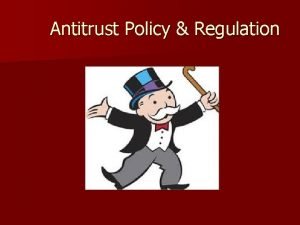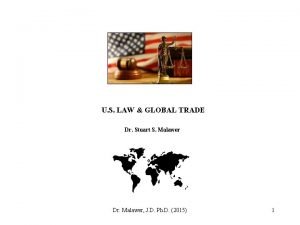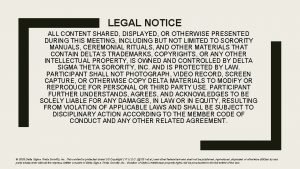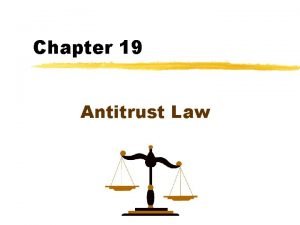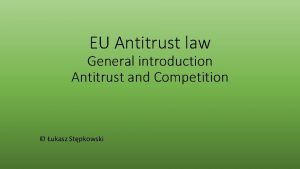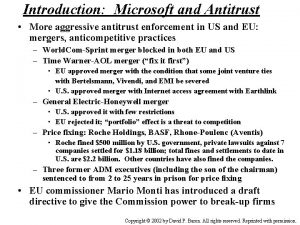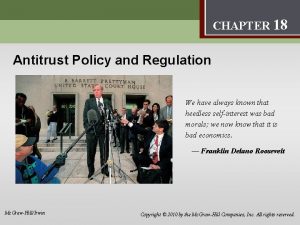The Economics of Antitrust An Introduction Russell Pittman








- Slides: 8

The Economics of Antitrust: An Introduction Russell Pittman “Economics at Community Colleges” October 5, 2012 The views expressed are not purported to reflect the views of the U. S. Department of Justice.

A Framework: Oliver Williamson and his “Tradeoff” The Economics of Antitrust: An Introduction October 5, 2012 2

An Overview What is the idea? ◦ Protection of the process of competition, for the benefit of consumers and the economy What is included in antitrust law? ◦ Agreements among firms ◦ “Monopolization”: Unilateral single-firm conduct ◦ Mergers and acquisitions What is not included? ◦ Price regulation (including “price gouging”) ◦ Profit regulation ◦ Consumer protection The Economics of Antitrust: An Introduction October 5, 2012 3

Agreements among enterprises (Sherman Act, section 1) Horizontal agreements ◦ Cartel agreements: the most serious violations “Per se” illegal No requirement to prove economic effect – Why? Criminal punishment in U. S. , increasingly elsewhere So how detect and prove? “Leniency” ◦ Joint venture agreements “Rule of reason” analysis Vertical agreements ◦ Examples: Exclusive contracts, Most Favored Nation clauses, tying, resale price maintenance ◦ Generally a competition problem only when market power present The Economics of Antitrust: An Introduction October 5, 2012 4

Monopolization (Sherman Act, section 2) Single-firm conduct. In most of the world, “abuse of a dominant position” Both “parts” of the offense must be present Two types of abuse ◦ It’s not illegal to have a dominant position, or even a monopoly ◦ You can’t abuse a dominant position unless you HAVE a dominant position ◦ Exclusionary abuses Most serious abuses: prevent the development of competition Most abuse cases are of this type Examples: Microsoft, Dentsply ◦ Exploitative abuses Monopolistic prices and profits, some types of discrimination Not many cases in most jurisdictions Generally not a part of U. S. enforcement The Economics of Antitrust: An Introduction October 5, 2012 5

Mergers and acquisitions (Clayton Act, section 7) The “latecomer” of the 3 principal provisions in US, EU law Most attention paid to horizontal mergers, though vertical mergers may be harmful as well – especially “foreclosure” issues Increasingly, agencies require “prenotification” ◦ An annoying and costly “tax” on multinational firms ◦ Increasing calls for international standardization The Economics of Antitrust: An Introduction October 5, 2012 6

Horizontal merger analysis: a standard methodology Market definition Market description and analysis Barriers to entry Competitive effects Efficiencies: The Williamsonian tradeoff ◦ What competes with what? What may be monopolized? ◦ Product and geographic dimensions ◦ CR 4 and HHI – but misleading appearance of precision, predictability ◦ Government regulations, scarce inputs, large minimum efficient scale, strong product differentiation, reputation ◦ “Timely, likely, and sufficient” ◦ Coordinated effects ◦ Unilateral effects ◦ Welfare standard: Total surplus or consumer surplus? ◦ Failing firm defense The Economics of Antitrust: An Introduction October 5, 2012 7

What else is competition law? Price controls? ◦ ◦ In principle, no. But sometimes political pressures are strong. Regulation of “natural monopolies”? Usually, no. But if no regulatory agencies, may handle by default, under “abuse of dominance” provisions. Consumer protection law? ◦ Misleading advertising, consumer fraud ◦ Some competition agencies enforce consumer protection law as well, including US FTC Overarching rationale is to protect the process of competition, allow the market to do its work The Economics of Antitrust: An Introduction October 5, 2012 8
